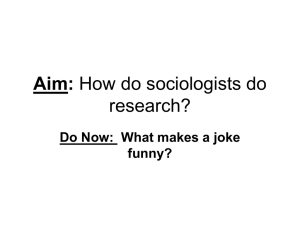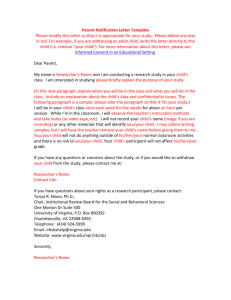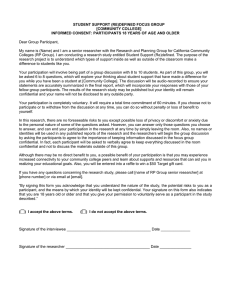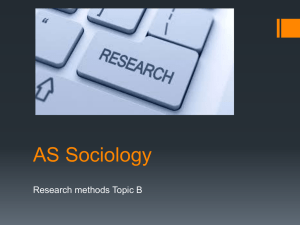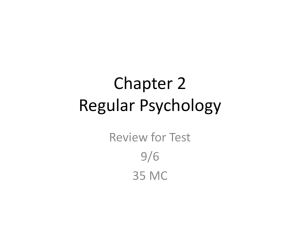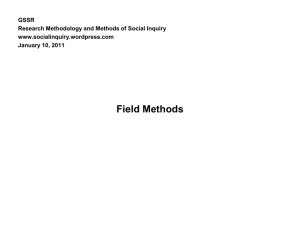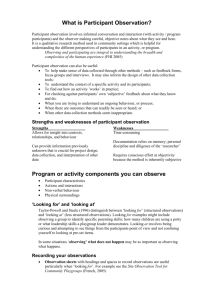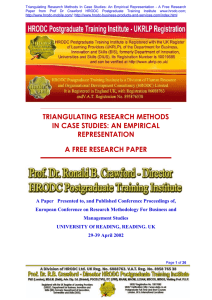Participant Observation
advertisement
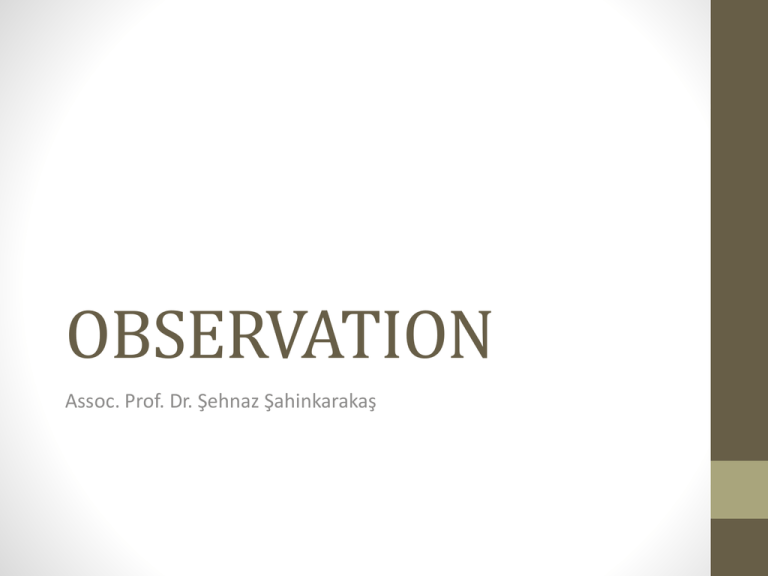
OBSERVATION Assoc. Prof. Dr. Şehnaz Şahinkarakaş Researcher’s Journal • Whatever method you use, try to keep a researcher’s journal • Writing notes as a diary, journal, memos… • Contains • • • • personal record of insights beginning understandings feelings recurring words/phrases, ideas, questions… • Try to keep it throughout the study • Make it as detailed as possible. OBSERVATION • For some studies, observation is the best technique as we can observe how people act and how things look. • There are mainly 2 different roles of the researcher in observation: • Nonparticipant observation • Participant observation Nonparticipant Observation • Researchers are not directly involved in the activity but “sit on the sidelines” or they have limited interaction with the people they observe. • Some observational data can even be collected unobstrusively (a teacher together with the students even in the break times can be an indicator of relationship between that teacher and the students) The roles of nonparticipant observer • Observer-as-participant: identifies herself but does not participate in activities. • E.g.: If you want to see what goes on in a school, you can interview with teachers, students, administrators, or visit classes, attend meetings but you do not participate in the activities. • Complete observer: opposite of complete participant. H/She observes the activities without participating in anything. Her identity may or may not be known. • E.g.: Observing the activities in the school yard. Participant Observation • Affected from early ethnographers • A participant observer • Attempts to enter the lives of others • Suspends as much as possible his/her own ways of viewing the world • In general, s/he asks questions such as: • What is happening here? • What is important in the lives of people here? • How would they describe their lives and what is the language they would use to do it? The roles of participant observer • Complete participant (covert): the researcher interacts with the members naturally throughout the study but his/her identity is not known to others. • E.g. Working as a teacher for a year and not informing the others that s/he is there to do research • Participant-as-observer (overt): S/He fully participates in the activities but his/her identity is known to the others. • E.g. Working as a teacher for a year but informing the others (teachers and students) that s/he is doing research. • Ethical Issues: • Observing people without their knowledge! • What do you think about this? Being There • The challenge to the qualitative researcher of being there: becoming invisible as a researcher • The researcher’s presence might be reacted to by the participants • But his/her unobstrusive presence can minimize this. • Then how much should we participate? • It depends! • «The challenge is to combine participation and observation so as to become capable of understanding the program as an insider while describing the program for outsiders» (Patton, cited in Maykut and Morehouse, 1994, p. 67). INSTRUMENTS TO BE USED FOR OBSERVATION • Many forms are available for observation. • Forms should be used on a trial basis before the actual data collection. • Possible problem: recording/writing too many things (watching too many children) General Observation Scheme • Environment of the Classroom: • 1. The classroom is on the _____ floor of the school building. • 2. The classroom is near • ( ) residential area • ( ) road(s) ( ) factories ( ) other • 3. Condition of lighting during the lesson: • ( ) bright ( ) dim ( ) dark • 4. Environments for listening • ( ) very quiet ( )occasional noise ( ) noisy Classroom Observation Scheme Instances per 10-min intervals Sources of feedback Notes Other feedback sources: Instructor Student Other Type of feedback Recast Repetition Nonverbal cue Other Other examples of feedback types Classroom Performance Checklist 2 Speaking Uses complete sentences Asks for help Answers questions Participates in conversations Stays on topic Restates ideas Understands what is being said Gets along with others 1 0 Behavior Rating Scale ADULT BEHAVIOR SCALE BEHAVIOR: Circle the number which best describes behavior over last 6 months Never or Rarely Occas. Often Very Often 1 Trouble wrapping up the final details of a project, when challenging part finished? 1 2 3 4 2 Trouble getting things in order, when doing a task that requires organization? 1 2 3 4 3 Problems remembering appointments or obligations? 1 2 3 4 • Problems of this rating scale: • Occasional, often and very often should be described as they might mean different to different observers. Observing one child (a) Considerations Does the child with the disability have access to the materials? Does the child use a variety of materials within the classroom? Does the child with the disability need support equipment? Is that equipment accessible? Is that equipment present? Does, or would, the needed support equipment interfere with interactions with either people or materials? Yes or No Comments Observing one child (b) • • • • • • Name of child: ______________________________ Birth date/age: ______________________________ Date of observation: ______________________________ The place the child is observed: __________________________ Classroom teacher: ______________________________ Time/day to check back with the teacher: ______________________________ • Purpose of Observation: • Notes: • • • Recommendations/follow-up: Tally Sheets • Used to record the frequency of student behavior, activities, remarks, etc. • Activities, behaviors… are listed on a piece of paper • Every time the activity, behavior… is observed, the researcher places a tally in the appropriate category Sample Tally Sheet Types of Pupil Behavior Observed Behavior Frequency Writing //// Reading // No Activity /// Talking to another pupil ///// ///// //// Talking to the teacher ///// // Disruptive Behavior Flow Charts • Good in analyzing group/class discussions. • The number and the direction of student remarks can be charted using different ways. • A seating chart with student names is needed. • Every time a student makes a verbal comment, a tally is placed in his/her box. Sample flow chart Interactions within a group Orkun / Altan // //// // /// Seyda Yasemin // // Ilker // Metin Anecdotal Records • A record of observed behaviors are written down in the form of anecdotes. • No set format: any behavior thought to be important is noted down. • Should be as specific and as factual as possible • Four types of anecdotes • 1. Evaluative statements: judging behavior as good or bad (should be avoided): • Julios talked loud and much during poetry; wanted to do and say just what he wanted and didn’t consider the right working out of things. Had to ask him to sit by me. Showed a bad attitude about it. • 2. Interpretive statements: making judgment on the basis of a single fact (should be avoided) • For the last week Sammy has been a perfect wiggle-tail. He is growing so fast he cannot be settled. … of course the inward change that is taking place causes the restlessness • 3. Generalized statements: describing certain behaviors in general terms (should be avoided) • Sammy is awfully restless these days. He is whispering most of the time he is not kept busy. In the circle, during various discussions, even though he is interested, his arms are moving or he is punching the one sitting next to him. He smiles when I speak to him. • 4. specific/ concrete descriptive statements: telling exactly what the child did (desired type) • The weather was so bitterly cold that we did not go on the playground today. The children played games in the room during the regular recess period. Andrew and Larry chose sides for a game which is known as stealing the bacon. I was talking to a group of children in the front of the room while the choosing was in process and in a moment I heard a loud altercation. Larry said that all the children wanted to be on Andrew’s side rather than on his. Andrew remarked: “I can’t help it if they all want to be on my side.” Sociometric Devices • It asks individuals to rate their peers in some way. • Mostly used instrument is sociogram: a visual representation of the choices people make Sample: Sociogram (interaction) Accepting to do an activity together: Refusing to do an activity together: …… One-way interaction: Two-way interaction: ---|--- Field Notes • Contain what has been seen and heard without interpretation! • i.e. Record what happened without judgement • --feelings to the participants (e.g. Patty looked bored) • --why or how something happened (e.g. I think Jeff is trying to impress Patty) • Your comments must be clearly set off from observations: • You can write them in brackets • You can use initials like OC (Observer’s Comments) How to write field notes! • Write during (if possible) or immediately after you leave the field • Begin by jotting down bits of information • Something you observed • Something someone said • Something that happened • Draw a diagram of the physical layout (if possible) • Organize your notes in a complete narrative: • • • • • • Describe people’s actions and interactions Note outside intrusions (alarm going off, phone call) Record verbatim words using quotation marks No quotations for paraphrased ones Set off your comments (brackets or OC) Note the time when needed Exercise • Think about a setting • Prepare a focus of inquiry statement (e.g. I would like to understand how ……..) • Allow yourself about half an hour • Write down as closely as possible what people said • Record exact words and statements that you remember • Draw a detailed diagram of the setting • Develop a descriptive account of what happened in the setting while you were there • the people you saw and heard • what happened and when • Add OC Exercise (Follow-up) • Reread your field notes, guided by these questions: • What is important here? • What is it that I need to find out more about? • What would I want to focus on more closely if I returned to this setting? • Evaluate your experience as a participant observer: • Were you able to separate description from interpretation? • Could someone reading your notes gain some understanding of what was happening in the class? • How accurately were you able to recall the physical setting, events, and conversations? What strategies aided your recall? (for notes taken after observation) • What will you do differently the next time you are in the field?
